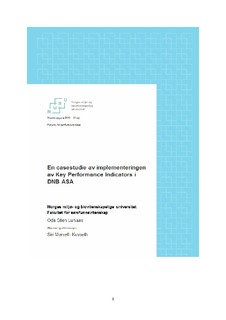| dc.contributor.advisor | Worren, Nicolay | |
| dc.contributor.author | Lunaas, Oda Stien | |
| dc.contributor.author | Kasseth, Siri Morseth | |
| dc.date.accessioned | 2016-08-31T11:53:43Z | |
| dc.date.available | 2016-08-31T11:53:43Z | |
| dc.date.issued | 2016-08-31 | |
| dc.identifier.uri | http://hdl.handle.net/11250/2403124 | |
| dc.description.abstract | This master thesis has been based on a single case study of the implementation of the Key Performance Indicator System in DNB. The purpose of the study has been to compare theory and practice, based on a selection of success criteria. The main research question is as follows:
“Existing theory identifies success criteria for the implementation process and the usage of KPI-systems. To which extent has DNB implemented their KPI System in line with these criteria?”
The thesis is also based on seven sub questions that have been investigated in order to answer the main research question. The seven sub questions each reflect the success criteria for implementing a KPI System. To be able to answer the research question, eight qualitative interviews have been conducted. The informants are all users of the KPI System in DNB. As a supplement, a document analysis has been conducted. The triangulation of methods has made it possible to compare the statements of the informants with a higher degree of “hard” facts.
The findings of the thesis reveal that the selection of success criteria for implementing a KPI System is partly present in DNB. However, the thesis has identified several limitations regarding the usage of the system that could impact how successful the implementation of the KPI System is. One of these limitations is related to the understanding of the KPI System and what a KPI consists of. As a result of poor communication and information sharing prior to implementation, the users have developed different understandings regarding the purpose of the system. It tends toward that there exists numerous understandings across the company as a result of that these aspect have not been well communicated to the users prior to the implementation. There can be several consequences of this. First, the users can experience finding the “right” KPIs as challenging. Secondly, the KPI System can be adopted differently, which can be unfortunate if some of the users do not see the usefulness of the system. Another limitation is related to how well the KPIs cover the overall strategy of the company. DNB’s strategy consists of the three areas capital, customer and culture. It appears that these strategy areas are covered unevenly, which can lead to an uneven realization of the strategic goals. This limitation can also be seen in light of the difficulty of choosing the “right” KPIs and the varying degree of understanding of the KPI System in DNB. As a result of these challenges one can assume that the potential of DNB’s KPIs are currently not fully exploited. | nb_NO |
| dc.description.abstract | Masteroppgaven er en casestudie av implementeringen av KPI-systemet i DNB. Formålet med oppgaven har vært å sammenligne teori og praksis, hvor det har blitt tatt utgangspunkt i utvalgte teoretiske suksesskriterier. Problemstillingen til oppgaven er som følger:
"Det foreligger eksisterende teori som identifiserer suksesskriterier for implementering og bruk av KPI-systemer. I hvilken grad har DNB implementert sitt KPI-system i tråd med disse kriteriene?”
Oppgaven består videre av syv delproblemstillinger som har blitt belyst for å på best mulig måte kunne besvare problemstillingen. De syv delproblemstillingene gjenspeiler hver respektive suksesskriterier for implementering av et KPI-system. For å kunne besvare problemstillingen er det foretatt kvalitative dybdeintervju med åtte brukere av KPI-systemet i DNB. Som et supplement er det også foretatt en dokumentanalyse. En slik metodetriangulering har åpnet muligheten til å belyse informantenes utsagn med mer ”harde” fakta.
Oppgavens funn viser at de utvalgte suksesskriteriene for implementering av et KPI-system delvis er tilstede i DNB. Det er imidlertid identifisert flere utfordringer tilknyttet hvordan KPI-systemet benyttes, noe som kan påvirke hvor suksessfull implementeringen av systemet i DNB er. Én utfordring er knyttet til forståelsen av KPI-systemet og hva en KPI innebærer. Det tenderer mot at det eksisterer flerfoldige forståelser på tvers av virksomheten som en følge av at disse aspektene ikke er klart kommunisert til brukerne i forkant av implementeringen. Konsekvensene av dette kan være flere. For det første oppleves det som delvis utfordrende å utlede gode KPIer. For det andre kan KPI-systemet tas i bruk ulikt, hvor dette kan være uheldig hvis ikke samtlige brukere ser nytteverdien av et slikt system. En annen utfordring er tilknyttet hvordan KPIene dekker den overordnede strategien. Strategien til DNB er tredelt, og består av områdene kapital, kunde og kultur. Det fremkommer at strategiområdene er ujevnt dekket, noe som kan medføre en skjevhet i målrealiseringen. Utfordringen med dette kan igjen sees i lys av vanskeligheten med å sette ”riktige” KPIer og den varierende graden av forståelse for KPI-systemet i DNB. Som en følge av disse utfordringene kan det antas at potensialet til DNBs KPI-system ikke er optimalt utnyttet per i dag. | nb_NO |
| dc.language.iso | nob | nb_NO |
| dc.publisher | Norwegian University of Life Sciences, Ås | |
| dc.rights | Navngivelse-Ikkekommersiell-IngenBearbeidelse 3.0 Norge | * |
| dc.rights.uri | http://creativecommons.org/licenses/by-nc-nd/3.0/no/ | * |
| dc.subject | Key performance indicators | nb_NO |
| dc.title | Et casestudie av implementeringen av Key Performance Indicators i DNB ASA | nb_NO |
| dc.type | Master thesis | nb_NO |
| dc.subject.nsi | VDP::Social science: 200::Economics: 210::Economics: 212 | nb_NO |
| dc.source.pagenumber | 177 | nb_NO |
| dc.description.localcode | M-ØA | nb_NO |

